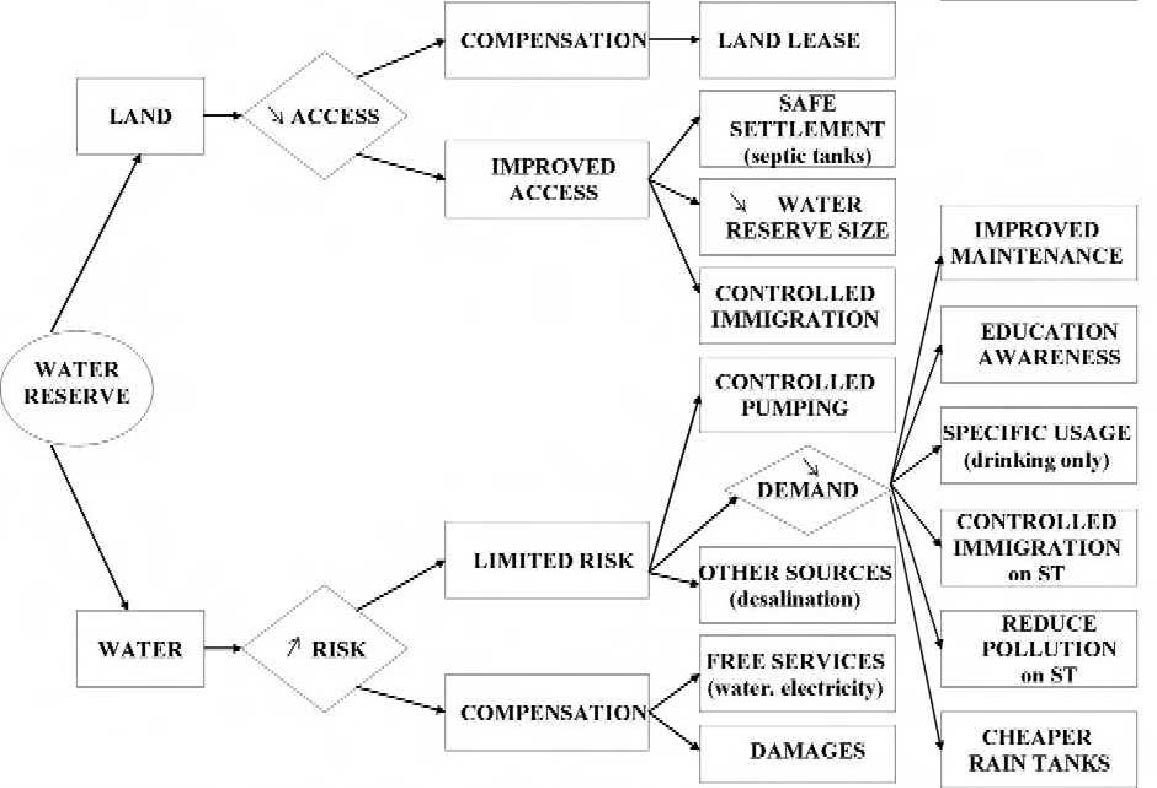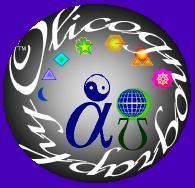White Waters and Upstreams Clean Waters Provisions
Basic Olicognograph: Ground Waters Management
From water we emerged. Of water we are. In sea sewers all will end
"6 basic characteristics that distinguish water as a vital and potentially contentious resource. 1) Water is necessary for sustaining life and has no substitute for human or animal use. 2) Both in terms of domestic and international policy, water issues are typically addressed by policymakers in a piecemeal fashion rather than comprehensively. 3) Since countries typically feel compelled by security concerns to control the ground on or under which water flows, by its nature, water is also a terrain security issue. 4) Water issues are frequently perceived as zero-sum, as actors compete for the same limited water resources. 5) As a result of the competition for these limited resources, water presents a constant potential for conflict. 6) International law concerning water resources remains relatively rudimentary and ineffectual".
Common modern geography, seeing to distort property rights makes observe: 1) Uses watercourses often ignore watershed catchment areas, 2) Uncared downstreams of transformed upstreams (by dams, extractions, waste waters) especially at international crossboarders, 3) Preference to set borders on watercourse rather than put at the middle of its catchment area, often against river's history of settlement. 4) Overextraction of underground waters.
Without reintroducing to known hydrologic cycle, remind definitions: "1) Non-Renewable Groundwater Resource: where available for extraction, of necessity over a finite period, from the reserves of an aquifer which has a very low current rate of average annual renewal but a large storage capacity. 2) Fossil Groundwater: where water infiltrated usually millennia ago and often under different climatic conditions, has been stored underground since that time. 3) Aquifer Overexploitation (Overdevelopment): by prolonged (multi-annual) withdrawal of groundwater from an aquifer in quantities exceeding its average annual replenishment, bringing about a persistent fall in groundwater levels and reduction of aquifer reserves with undesirable sideeffects. 4) Groundwater Mining: extraction of groundwater from an aquifer having predominantly non-renewable resources with depletion of aquifer reserves".
"Water can be split up into 5 levels of usage instead of the traditional 2 of 1) drinking (potable) water and 2) wastewater (sewage). These are: 1) ultra-pure water (ex. for use in making semiconductor chips); 2) de-ionized water (for use in biological or pharmaceutical processing); 3) drinking water (for use in kitchens, cafeterias, water fountains, etc.); 4) wash water (to clean delivery trucks, buildings, etc.); 5) irrigation water (for use on lawns, shrubs, trees, etc.)".
The deficit of water resources limits directly and severely the social-economic development and ecological environment protection in many regions and, has been exacerbated by rapid industrial growth, national and state agriculture production objectives. Recent national, provincial and local water reform efforts are also focusing on economic efficiency in water allocation. The amount of allocated water is a multi-dimensional variable and can be optimized in many contexts due to differences in the definition of industrial structure, the technical levels of production among different areas and the marginal revenues of water resources". Meanwhile concern about waters war are increasing all over the world.
"Watershed is an important component of rural development and natural resource management strategies in many countries. A watershed is a special kind of common pool resource: an area defined by hydrological linkages where optimal management requires coordinated use of natural resources by all users. Management is difficult because watershed systems have multiple, conflicting uses, so any given approach will spread benefits and costs unevenly among users. Theories from commons research predict great difficulty in managing complex watersheds and explain why success has been limited to isolated, actively facilitated microwatershed projects with a focus on social organization. Encouraging collective action is easiest at the microwatershed level but optimal hydrological management requires working at the macrowatershed level. Resolving the tradeoffs is necessary for widespread success in watershed development but solutions are not clear. Watershed projects in developing countries that focus on water harvesting and soil conservation typically state three objectives: 1) conserve and strengthen the natural resource base, 2) make agriculture and other natural resource-based activities more productive, and 3) support rural livelihoods to alleviate poverty".

"Freshwater augmentation alternative techniques: 1) Rainwater harvesting: - roof catchments - in situ, 2) Fog harvesting, 3) Runoff collection: - paved and unpaved roads - surface structures - underground structures, 4) Flood diversion 5) Water conveyance: - marine vessels - pipelines, rural aqueducts, water tankers, 6) Artificial recharge of aquifers: - infiltration barriers and canals - water traps - cutoff waters - surface runoff drainage wells - septic tanks - effluent disposal - wells - diversion of excess flow from irrigation canals into sinkholes. 7) Groundwater pumping using non-conventional energy sources: - hydraulic pumps - hydraulic ram - rope pumps - hand pumps - windmill driven pumps - photovoltaic pumps.
Water quality improvement can look at: 1) Desalination: - reverse osmosis - distillation, 2) Clarification: - plants and plant material, 3) Disinfection: - boiling - chlorination, 4) Filtration: - residential filters - slow sand filters, rapid sand filters - dual and multimedia filters
Wastewater treatment & reuse: 1) Wastewater Treatment - oxidation ponds - stabilization lagoons - septic tanks - anaerobic filtration - sludge layer systems -hydroponic cultivation/root - zone treatment - activated sludge in vertical reactors, 2) Wastewater euse Water conservation: - raised beds and waru-waru cultivation - small scale clay pot and porous capsule irrigation systems - automatic surge flow - gravitational tank irrigation systems - dual water distribution systems - others".
Safe water
"Water balance of an organism is the water intake as a liquid, the water in food and the water of oxidation; less the water output (water in urine, feces, or other excreta, water expended in sat- saturating respired air, water lost through the integument)". Care the 1) Amount requirements, 2) Dynamic of needs according environment and activities, 3) Quality, 4) Thermal balance, 5) Water balance, 6) Extralosses (from heat, diarrhoeas, vomits), 7) Mineral balance, (sodium, potassium, magnesium) and hardness (calcium) 8) Microbiological safety (virus, bacteria, parasites), 9) Mineral and Chemical pollutions (radionucleides, mercury, lead, nitrates ...), 10) Organic pollution (insecticides, pesticides, mineral-oils, oxygen-bounded-disponibility).
"As far as possible, water sources must be protected from contamination by human and animal waste, which can contain a variety of bacterial, viral, and protozoan pathogens and helminth parasites. Failure to provide adequate protection and effective treatment will expose the community to the risk of outbreaks of intestinal and other infectious diseases. Those at greatest risk of waterborne disease are infants and young children, people who are debilitated or living under unsanitary conditions, the sick, and the elderly".
Example of Water Management National Program |
|
Development of technology to ensure a sustainable water resources |
Technology for development of alternation water resources, Reuse of waster water, water conservation, reuse of rainfall, high efficiency desalinization, Technology of integrated water resources management, Optimum operation technology of water resources, Technology to overcome drought |
Development of technology to ensure a sustainable water resources |
Operation/Maintenance system of water distribution systems, Expert system for water distribution systems assessment, Investigation of biological regrowth in water distribution systems, Optimal operation of water transmission systems |
Conventional Water treatment |
Assessment of water treatment plants (CPE and CCP), Direct filtration, Dual-media and deep coarse-sand filtrations, Control of coagulation / flocculation processes with SCD, Inclined tube settling basins and Dissolved Air Flotation (DAF), Reuse, dewatering and thickening of sludge |
Advanced Water Treatment |
Membrane process (micro-and ultra-filtrations) Ozone and Biological Activated Carbon (BAC) processes, Sea water desalination (RO membrane) |
Water Quality Analysis |
Investigation of Giardia and Crypto in raw and treated water, Analysis of algal toxins (microcystin and anatoxin), Analysis of endocrine disruptors, Investigation for water sources. |
Wastewater treatment for reuse, Advanced wastewater treatment (Removal of N-sodium and P-phosphorus) |
|
Water Treatment Equipment and Facilities |
Design of rapid mixing basin and impellers using CFD, Calibration of flow meters, Standardization of power control circuits. |
Water Upstream (or pre-filthy) Management
"Water management is not just the development of irrigation and power projects. It represents a lot of things, not least of which is the involvement of waste management. We do not just want water, we want water which is fit for human consumption. In addition to this, there is the need to involve the private sector in the management of water resources, without in anyway allowing them an oligopoly on the same. To do this in a manner which also gives them a decent operating return requires the most careful thought and structuring".
"Besides the economic, social and technical considerations in water resources planning, the environment effects is another important issue, since the positive aspects of increasing clean water irrigation and reducing urban surface sinking; to the negative aspects of alkalinizing and waterborne disease spread".
"It is relatively simple to evaluate the direct return on public water supply capital because drinking water has most of the characteristics of a private good, since it is both rival and excludable. Moreover, few external costs or benefits likely attach to the production and consumption of potable water at the margin in a developed country. In poor countries where unhealthy water is a major cause of disease, this would not be the case drinking water market is characterized by public provision of a private good, usually by a monopoly not-for-profit municipal water undertaking. Although the incidence of un metered 'free' water is increasingly rare, it is unlikely that prices reflect social marginal cost".
Water management in developing worlds poor neigborhoods: "Challenges are: 1) Collection of user charges: the mechanism of collection is a difficult one, particularly in the slums and poorer urban neighborhoods where the local mafia tend to get involved. This is where the community-based organization could play a major role. 2) Proper legal framework: necessary legal infrastructure to make private water management a viable business. There needs to be policy in place and legislative development should take place at the Central, State and local levels. Effective legislation flows from policy and therefore it is the development of policy that is most urgently needed. In this matter, water management lags way behind Telecom, IT infrastructure or even Power 3) Exploitation of groundwater: Many critics opine that groundwater will be depleted if private bodies handle this resource, as they are highly commercially oriented and invest".
